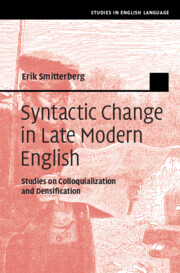Book contents
- Syntactic Change in Late Modern English
- Studies In English Language
- Syntactic Change in Late Modern English
- Copyright page
- Contents
- Figures
- Tables
- Acknowledgements
- Chapter 1 Introduction
- Chapter 2 Sociocultural and Linguistic Change in Late Modern English
- Chapter 3 Aspects of Language Change
- Chapter 4 Methodological Framework
- Chapter 5 Colloquialization I: Not-Contraction
- Chapter 6 Colloquialization II: Co-ordination by And
- Chapter 7 Densification I: Nouns as Premodifiers in Noun Phrases
- Chapter 8 Densification II: Participle Clauses as Postmodifiers in Noun Phrases
- Chapter 9 Concluding Discussion
- Appendix
- References
- Index
Chapter 4 - Methodological Framework
Published online by Cambridge University Press: 19 November 2021
- Syntactic Change in Late Modern English
- Studies In English Language
- Syntactic Change in Late Modern English
- Copyright page
- Contents
- Figures
- Tables
- Acknowledgements
- Chapter 1 Introduction
- Chapter 2 Sociocultural and Linguistic Change in Late Modern English
- Chapter 3 Aspects of Language Change
- Chapter 4 Methodological Framework
- Chapter 5 Colloquialization I: Not-Contraction
- Chapter 6 Colloquialization II: Co-ordination by And
- Chapter 7 Densification I: Nouns as Premodifiers in Noun Phrases
- Chapter 8 Densification II: Participle Clauses as Postmodifiers in Noun Phrases
- Chapter 9 Concluding Discussion
- Appendix
- References
- Index
Summary
In this chapter, the idiolect-centred approach to language change is reconciled with historical corpus linguistics as a methodology. The issue of what corpus-based studies can and cannot tell us is discussed in terms of the granularity of the analyses. The two types of change in focus in the case studies, colloquialization and densification, are introduced. The two main ways of operationalizing frequency in syntactic studies, namely variationist and text-linguistic approaches, are contrasted. Finally, the two corpora on which the case studies are based, CONCE and CNNE, are introduced; CNNE and its relationship to the newspaper market in nineteenth-century England is discussed in some detail, as CNNE is a new corpus and as the newspaper trade underwent far-reaching changes during the period covered by the corpus. The importance of considering a wide variety of genres owing to the increasing linguistic genre differences that characterize Late Modern English is emphasized.
Keywords
- Type
- Chapter
- Information
- Syntactic Change in Late Modern EnglishStudies on Colloquialization and Densification, pp. 77 - 126Publisher: Cambridge University PressPrint publication year: 2021

